10 Best Winter Treks in Nepal
Trekking in lower elevations is much more practical during the cold winter months in Nepal.
Trekking in lower elevations is much more practical during the cold winter months in Nepal.
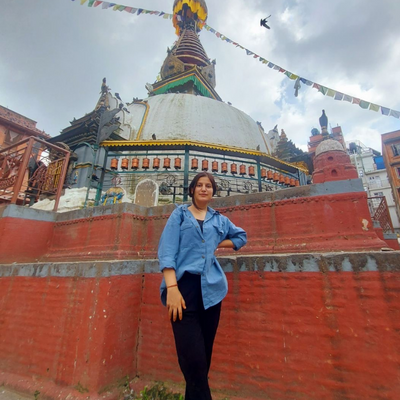
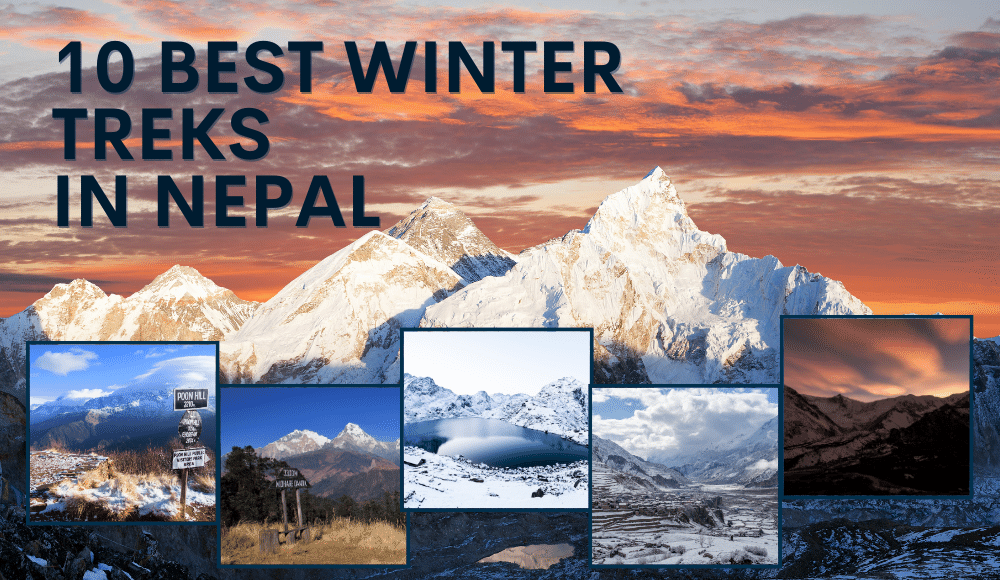
Weather and Climate, these two are the mighty behind every thriving hike and trek. According to the weather, the treks vary, either the trek will be fruitful or become the worst nightmare. All over, many treks favour the colourful and vibrant Autumn, and Spring while some favour the gloomy and nippy winter too. It's pretty fascinating to know that some treks are best suited and worthwhile even during the winter months.
Nepal, a county of glam, glory and wonder boasts several excursions, trips and treks. Whenever the term trekking in Nepal emerges, most enthusiasts buy this, “yeah probably in the spring and autumn”. But hell no! Trekking in Nepal is even possible during the chill crisp winter months. And Surprisingly, this gets the best reaction you could ever ask, dumb wide eye stare questioning “like really”? To your surprise, a big yes! Nepal with its startling features surprises everyone in this context too as there are several winter treks feasible here in Nepal.
The winter treks in Nepal are grouped by region, As some are viable in the Everest region, Some in Annapurna, Some in the Langtang region, Some in the Western part and likewise. Here in this article, I am going to unfold the ten best winter treks in Nepal which include the Langtang valley trek, Ghorepani Ghandruk trek, Manang trek, Mohare trek, Pikey peak trek, Everest view trek, Mardi short trek, Tamang heritage trail, Shey Phoksundo lake trek, and Panch Pokhari lake trek.
These treks are not just theoretically the best, but actually the real gem for the absolute adventure seeker. Not just through the web pages, sites and links fiddling, but we have listed the above-mentioned trek on our own personal ventures and experiences, observing the temperature, climate, possible hindrances and potentials of that region. If this gets your attention, and you are really interested to learn more about the winter treks in Nepal, stay put with this article. This will feed all the rising confusion of yours!
Nepal mainly experiences four seasons throughout the year, Autumn, Spring, Winter and Summer. As everyone knows autumn and spring here get the most guests of all time. A good question to answer would be “When is the winter season in Nepal?” It's from December to February. December marks the beginning of the winter months while late February indicates its end. The temperature drops rapidly in January making the nights frigid and days slightly warmer.
The atmosphere is clear and especially, the dusk is phenomenal in this period with the sunset after the hills and the sky in the shades of red, orange and peach. The flock of birds soaring high in the sky in return to their shelter as soon as the clock hits six is another mesmerising charisma of the winter months. The chill, cool air bending on the way surfing through your hair strands is what makes the winter in Nepal more exceptional and tempting.
During winter months, The temperature is uneven throughout the country. It deviates by region, as the Everest region experiences extreme cold, followed by the Annapurna region and others. So, obviously, you will not trek in the upper Everest region in this period as nobody wants to be the prey of the huge wild avalanches and the snowstorms.
Get in touch with our experts right away and finalize an experience!
About UsTrekking in Nepal itself is the most preferred adventure activity. On top of that, the winter treks in Nepal are like a cherry on top. It vests you with incredible lifelong remembrance and is something to cherish throughout. Trekking in the winter comes with a totally different experience in the landlocked mountainous country of Nepal.
As people usually trek in the spring, and autumn, winter treks are the best to avoid the crowd and get lost in the scenic nature of Nepal. You will get the best of all the trails during this time as the snowbed on top of the peaks with a charming environment all around and that comfy cosy sleep at the end of the day makes the trek even more fun and pleasant.
Marching through the secluded trails on the hilly tops is a winter trek all about. Unlike other times, you need to especially look after the trekking backpack guide and essentials during this time’s trek. Also, look after the weather forecast before plunging on any trek at this time. Some of the best winter treks in Nepal are discussed below. You could pay a visit to that too.
|
|
|
|
|
|
|
|
|
|
One of the nearest treks from the Capital Kathmandu is the Langtang valley trek. This trek is overshadowed by the popular yet commercial trek of Everest and Annapurna region but feeds the best panorama prominent in the Langtang national park. The starting point of the Langtang valley trek is Syabrubesi. It is just 180 km far from Kathmandu, and it may take around 7 to 8 hours to get here through the drive. Also, if you are getting here through Pokhara, you need to get up to the Galchi first and then join the trails of Betrawati highway leading to Syabrubesi.
|
Name |
Langtang valley trek |
|
Location |
Rasuwa district |
|
Trek Starting and Ending point |
Syabrubesi |
|
Trek Duration |
10 to 11 days |
|
Highest point |
Kyanjin Ri |
|
Elevation |
4600 m |
|
Major Attractions |
|
|
Permits required |
Langtang national park permit TIMS card |
|
Difficulty level |
Moderate |
|
Accommodations |
Teahouses |
Langtang valley, popular as the valley of glaciers, offers you the best of Langtang national park. It lies in the district of Rasuwa and is the highlight of the Langtang region. Langtang Lirung is the major peak of this region, and from which flows the largest glacier of this region, Lirung glacier. Also, the peaks such as Dorje Lakpa, Loenpo Gang, Changbu, and many others are spotted from the Langtang valley.
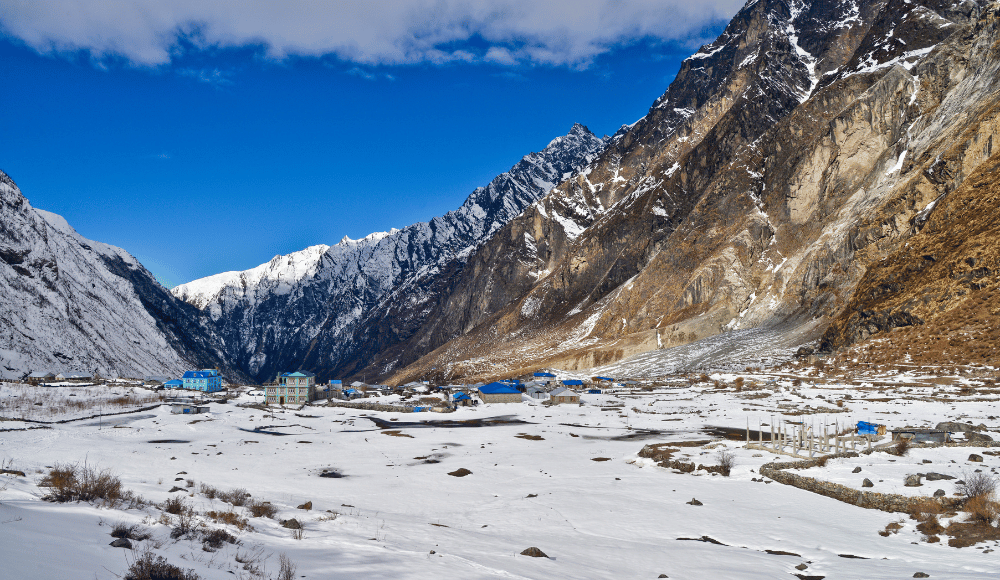
The initial trails to the Langtang valley go by the river's shore following the alpine forests. Mainly rhododendrons are the wide vegetation of this region, and you will trek alongside it which is quite an exquisite experience. Also, the red panda, an endangered species, is the major habitat of this national park, so if you are lucky enough you may get a peek into the susceptible Red panda.
Not only the flora and fauna of this national park, but the Langtang valley trek also takes you to the beautiful Langtang village. This is the small Tamang village nestled in the lap of Langtang Lirung. Here you will get a glimpse of Tamang lifestyles, cultures and traditions. Up above from the Langtang village is the popular Kyanjin Gompa, where the trekkers rest before their ascend to Kyanjin Ri. There are multiple lodges and teahouses in this region, and this gives the best view of the landscapes, glaciers, and mountains of the Langtang region.
Ghorepani Ghandruk trek, commonly popular as the Ghorepani Poon Hill trek is short yet the best trekking trail in Nepal. Mainly in the spring and autumn a huge mass forms in these trekking trails, but that doesn't mean it can’t be visited in the winter. This is actually the best time as you can have the whole trail on your own. This Ghorepani Ghandruk trek starts from Nayapul and ends in it. This lies within the Annapurna conservation area and is preserved by the ACAP unit till now.
|
Name |
Ghorepani Ghandruk trek |
|
Location |
Annapurna region |
|
Starting and Ending point |
Nayapul |
|
Trek Duration |
3 to 4 days |
|
Highest point |
Poon hill |
|
Highest Elevation |
3210 m |
|
Major attractions |
|
|
Permits required |
ACAP permit |
|
Difficulty level |
Easy |
|
Accommodations |
Homestay, Teahouse and Lodges |
The initial trail of this trek takes you through the beautiful Gurung settlements, staircases, woodlands and the farmland where you can find the locals engaged in barley, potato harvest. After an overnight stay in the Ghorepani, the next day's trek will be up to the glam zone, Poon hill. From Poonhill, you can get breathtaking sunrise views of the peaks Annapurna, Hiuchuli, Lamjung Himal, Ganesh Himal, and many more. Annapurna massif looks fabulous from here. And this is exactly the highlight of this Ghorepani Ghandruk trek.
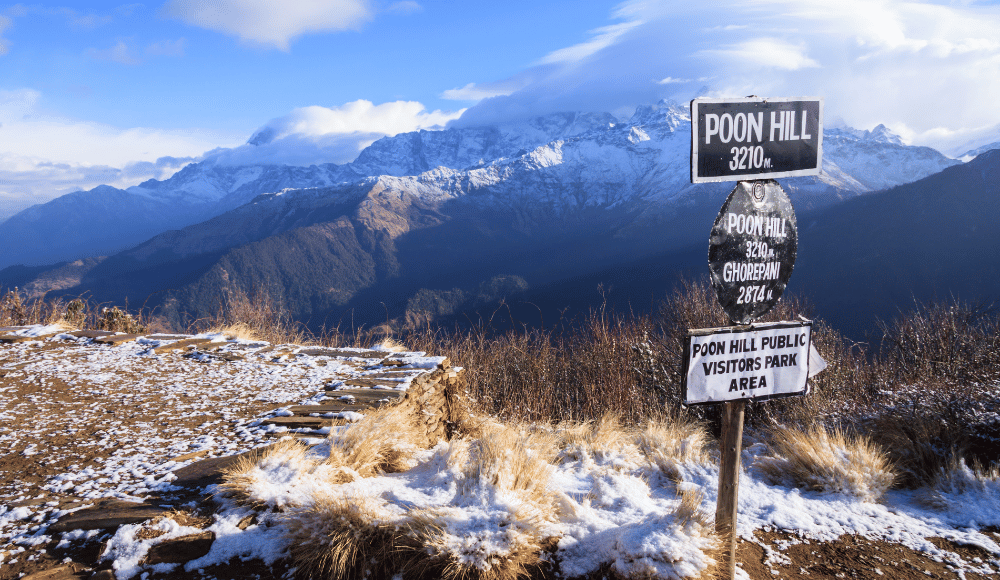
Getting sufficient Sunrise from the infamous Poonhill, this trek descends up to the cultural valley of Ghandruk. Here you can observe the traditional houses with the ancient architecture, and the unique practices of the locals. The homestay facility and the warm hospitality of the locals are another limestealer of this gorgeous Gurung village. There is also a museum nearby the village, you can pay a visit there too, where you can get more knowledge of the Gurung ethnic community and their artefacts.
Also, there is not that much risk of getting altitude sickness in these regions, hence this trek is favoured by many and can be visited all year round except for the monsoon seasons. The trails are nice and easy and you can get a touch of Himalayan countryside lifestyles, and practises along with the jaw-dropping mountain vistas during this trek.
Manang, the smallest district of Nepal, also called the district beyond the Himalayas is the cultural hub of the Annapurna region. Though it is the smallest in context to the area, it is the richest in the matter of nature, and resources. It shares the northern border with the Tibetan autonomous region of China, hence got some part of it in the list of restrictions. Because of this, the upper region of this district is highly influenced by Tibetan culture, and you can feel it during your trek to Manang.
|
Name |
Manang trek |
|
Location |
Manang district, Annapurna region |
|
Starting point |
Dharapani |
|
Ending point |
Besisahar |
|
Trek Duration |
8 days |
|
Highest Elevation |
3540 m |
|
Major attractions |
|
|
Permits required |
|
|
Difficulty level |
Moderate |
|
Accommodations |
Teahouse and lodges |
Manang trek, an ecological trek takes you to the diverse flora and fauna of the Annapurna region. Aiding the beauty are the ancient Gompas and the settlements in the valley of the Marshyangdi. This Manang trek is usually the stopping trek of the renowned Annapurna circuit trek and the Tilicho lake trek. Because of these treks, the local economy is aiding day by day and the Manang has got the hype among the crowd. Also the Himalayan transporter, yaks, are seen marching on the trails which is quite fascinating and the locals involved in the paddy, millet, and potato harvest immerse you into the rural Himalayan lifestyles. The multicoloured prayer flags spread the religious belief and importance of the locals while the myriad landscape lures the trekkers into its spell.
Not just the sole Manang trek, you can join the Upper Mustang trek and Muktinath trek through this trek which goes via Thorong la pass. Since the Thorang la pass gets covered by snow during winter, you need to think again before trying the Thorang la pass from here. Apart from this, the locals, their customs, countryside vibes, remote villages, and the magnificent landscapes make the Manang trek worthwhile even during the winter months.
Pikey peak trek is the recent famous trek of the Everest region. As I mentioned the Everest region, you may have thought, how is trekking to the Everest region possible in the winter season? But, it is possible, as this trek will not take you to the upper Khumbu region, and traverse around the lower one. Also unlike the Everest base camp, Kalapathar and Gokyo lake trek, this trek is quieter and obviously less crowded.
|
Name |
Pikey peak trek |
|
Location |
Lower Khumbu, Everest region |
|
Starting point |
Dhap |
|
Ending point |
Phaplu |
|
Trek Duration |
10 days |
|
Highest Elevation |
4065 m |
|
Major attractions |
|
|
Permits required |
Sagarmatha national park permit |
|
Difficulty level |
Moderate |
|
Accommodations |
Teahouse and Lodges |
Actually what happens in the Everest region trek is, there is always someone following you or you are the one following someone. And this kinda turns that excitement off as you want to be closer to nature not with the crowd and any other fellows. But this Pikey peak trek is unique and different to that, you can’t find a crowd ahead and behind you. There are few teahouses on the trail, and the trail is surprisingly nicer and more explicit. Also, the trek is not that difficult either as you will trek for around 4 to 5 hours each day through various plains and topography of the Khumbu region.
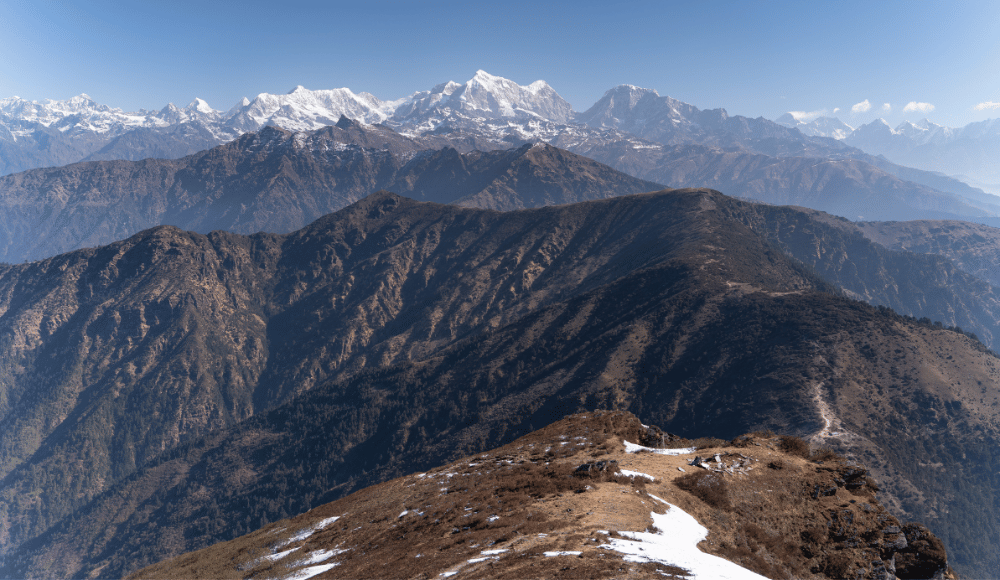
The pikey peak trek carries along the beautiful Sherpa settlements, woodlands, grasslands, Mani walls, Chortens, alpine pastures, Vintage villages, monasteries and landmarks. From Pikey peak, you will get the best sunrise and sunset view behind the mighty Everest. Many treks to the Kalapathar, and Gokyo lakes, which is tough and hard just to get the marvellous sight of Everest but this pikey peak bestows you with all the Everest views you could ever ask. Also, Not only Everest you could get the most pleasing mountain vistas of the Khumbu region during this trek.
Pikey peak trek gives you insights into the Sherpa culture and customs. The monasteries on the trails demonstrate their cultural beliefs and the crafted mani stones on the trail's edge represent the religious aspects. Lamas and monks performing prayer in their traditional attire, children running here and there, sparsely scattered flora and fauna of the Sagarmatha national park and locals immersed in their daily activity make the pikey peak trek even more intriguing.
Everest view trek is the shortest trek in the Khumbu region. This trek will only lead you to the Everest view hotel which offers the finest views of the dazzling Everest. Not only Everest, but you can also get a peek at Ama Dablam, Cho Oyu, Lhotse, Makalu, Kang Tega and many more during this Everest trek. This trek starts with a scenic flight to Lukla airport, which itself is an adventure.
|
Name |
Everest view trek |
|
Location |
Khumbu region |
|
Starting and Ending point |
Lukla |
|
Trek Duration |
9 days |
|
Highest Elevation |
3840 m |
|
Major attractions |
|
|
Permits required |
Sagarmatha national park permit |
|
Difficulty level |
Moderate to Difficult |
|
Accommodations |
Teahouses and Lodges |
This Everest view trek, normally called Everest panorama trek is a moderate level trek as you will trek along the river shore, through the woodlands inside the Sagarmatha national park. You may even encounter the Himalayan Thar, and musk deer during your trek to the viewpoint, but expecting the elusive Snow Leopard may disappoint you as they wander around the highest elevation. On the trail lies the horseshoe-shaped mountain city and trade centre, Namche Bazar. It feeds the first-ever Everest view. Trekking up, even more, will take you to the beautiful Khumjung village. Khumjung, Khunde, and Thame are the traditional sherpa villages which are veiled from the modern outcast, hence you can get authentic mountain life up here.
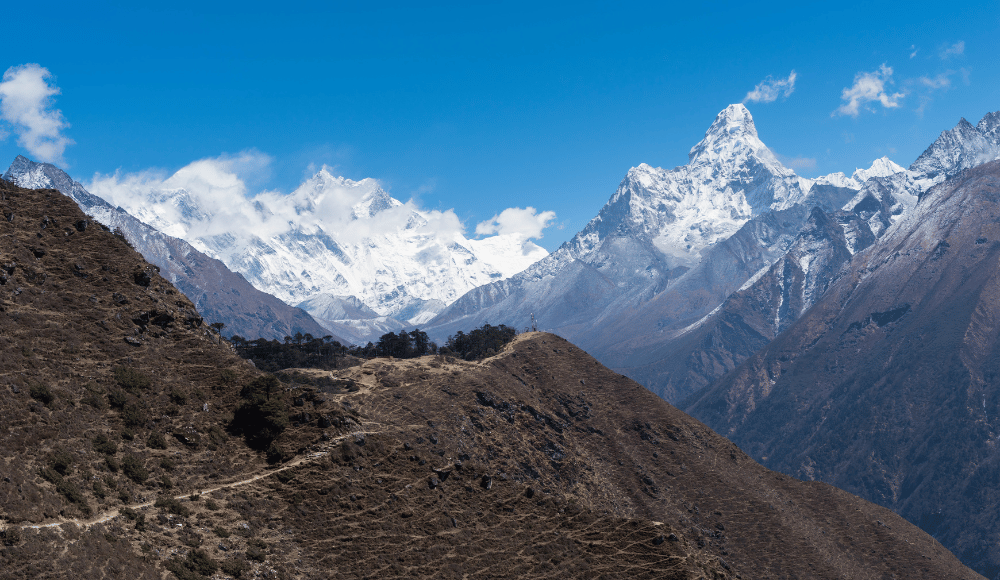
The trek through the pine, birch, juniper and rhododendron forests makes the Everest view trek momentous and delightful. Even more during the winter season, the forest changes its shades and provides a warm welcome to the visitors. As discussed above, The prime attraction of this trek is the Everest view complemented by the other snowy peaks. So, This trek is ideal for those who have limited time but want to gaze at Everest.
If you like you can extend this trek up to the Tengboche, as there is the oldest monastery in this region, Tengboche monastery. Also, from Namche different helicopter tours operate. If you don't want to trek but want to get to Everest as close as possible you can join the Everest Kalapathar helicopter tour. This will grant a 360-degree view of the mountain giants in the Everest region. Additionally to this, there is the option of a helicopter tour of Gokyo valley and lakes from Namche. You can join that too.
Not only Namche, but you can also join the helicopter tour directly from Kathmandu such as the Everest base camp helicopter tour if you don't have a long vacation. This will accomplish your quenching thirst for seeing Everest up and close.
Mardi short trek is the most popular short trek of the Annapurna region in recent days. The trek starts from Kande, ends at Siding and can be joined up to mid-January. Mardi Himal is the centre attraction of this trek with its elevation of 5587 m lying below the Macapuchree, in the east of the Annapurna range. The highest point of this trek is 4500m, which is the Mardi base camp. This trek is easy to moderate and a beginner can join this trek.
|
Name |
Mardi short trek |
|
Location |
Annapurna region |
|
Starting point |
Kande |
|
Ending point |
Siding |
|
Trek Duration |
4 to 5 days |
|
Highest Elevation |
4500 m |
|
Major attractions |
|
|
Permit required |
ACAP permit and TIMS card |
|
Difficulty level |
Moderate |
|
Accommodations |
Teahouses and Lodges |
The Mardi short trek usually lasts for 4 to 5 days. To start this trek, first, you have to reach Kande and then trek onwards. It's not that Kande is the only starting point of this trek, as there are multiple trail options, but Kande is the easiest and most feasible for almost everyone. The initial trails of the Mardi Himal trek take you through the farmland and woodlands which climb up to the Australian base camp. You can see multiple lodges and teahouses here.
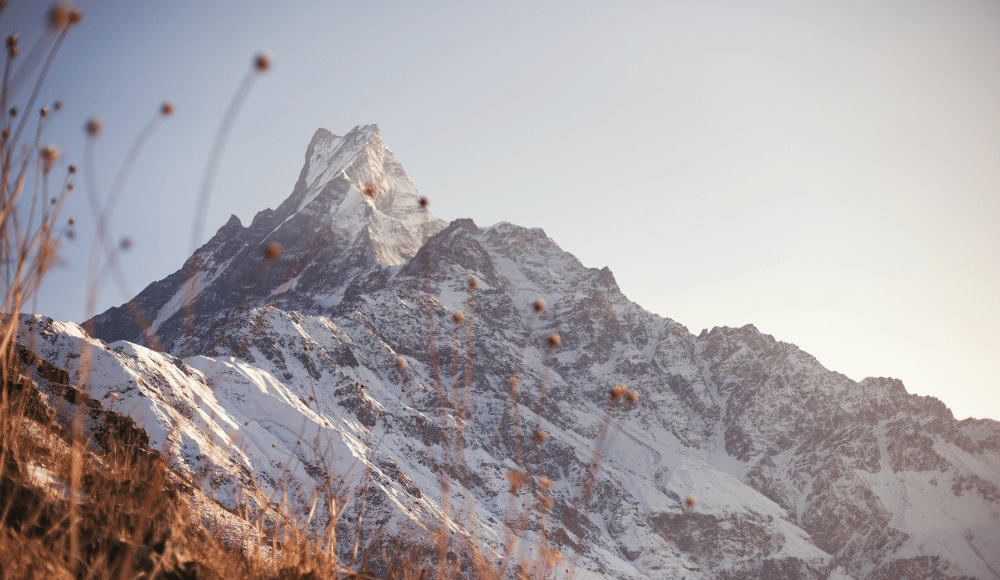
After Australian camp, you will trek through Pothana, Deurali, Low camp, Forest camp, High camp and then finally the Mardi base camp, which will be your destination for this trek. From the base camp, you can peek at the beautifully settled valley and smiling mountain ranges. All these trails lie in the shadow of a fishtail, which means you will be walking facing the Glamorous Machhapuchhre. The trails include a few ascends, descends, forest walks, hill stations, rhododendron bushes, pastures, and alpine meadows.
Especially after the high camp, you will find this trek more meritorious as you will be greeted by the wild flowerbed. You can notice multi-colored wildflowers blooming grandly till your eyes can get. Aiding the beauty will be the grazing yaks, sheep, goats and the bystander, magnificent Annapurna, Macapuchree, Hiuchuli and many other peaks. All the blooming flowers, pastures and crystal mountains really make this Mardi Himal trek a struggle to meet Eden.
Related read: 10 best short treks from Pokhara
Nepal is not just a country of nature but also home to several races and ethnicities. And this Tamang heritage trail, a mecca of the Langtang region, verifies a point regarding this. This Tamang heritage trail will take the trekkers to the northern Himalayas practice of Nepal, more specifically a submersion into the Tamang culture through the village of Golijung and Gatlang.
|
Name |
Tamang Heritage trail |
|
Location |
Langtang region |
|
Starting and Ending point |
Syabrubesi |
|
Trek Duration |
14 days |
|
Highest Elevation |
3860 m |
|
Major attractions |
|
|
Permits required |
Langtang national park permit and TIMS card |
|
Difficulty level |
Moderate to Strenuous |
|
Accommodations |
Teahouses and Lodges |
The entire trek lies within the Langtang national park, which is the third most visited and explored region of Nepal. During this heritage trek, you will scour around the Tamang communities of the Langtang region which indeed include the villages of Golijung and Gatlang. These two villages boast the pure Tamang cultures and practices of this region. A surprising fact of this trek is, you can even find the shamans, their acts, and values inside the upper villages trek.
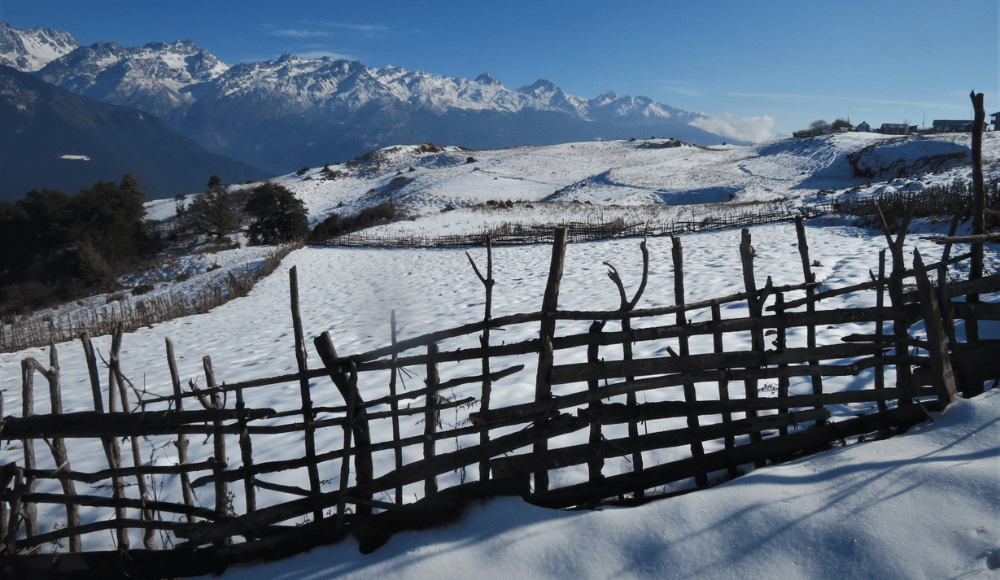
Apart from the culture and tradition of the Tamang ethnic groups, this trek offers the best views of the peaks of Langtang Lirung, Kerung and Ganesh Himal. You will also catch several waterfalls, sacred lakes and monasteries of this region during the day-to-day heritage trek. Also the most popular trek of this region, the Gosaikunda lake trek starts from Dhunche, the capital of Rasuwa. You could extend this trek and join that trek too if you would like.
The dreadful Havoc of 2015, earthquake, has affected the Langtang village the most, so you could explore that region too during this heritage trek. Now the village has shifted up above 100 m and is slowly developing there.
Related trip: Langtang Gosaikunda Lake Trek
A possible alternative to the crowded Poon hill trek is the Mohare hill trek. As the name itself mentions the ‘hill’, there is no need for further explanation that it is a hill station offering spectacular mountain views. Mohare hill trek is the eco-lodge community trek lying in Myagdi district only 3 km afar from Poon hill. From this hill point, you will get astounding sunrise and sunset views of peaks Dhaulagiri and Annapurna.
|
Name |
Mohare hill trek |
|
Location |
Myagdi district, Annapurna region |
|
Starting and Ending point |
Nayapul |
|
Trek Duration |
10 days |
|
Highest Elevation |
3300 m |
|
Major attractions |
|
|
Permits required |
|
|
Difficulty level |
Easy to Moderate |
|
Accommodations |
Community lodge |
Mohare hill trek is an easy to moderate level of the trek in the Annapurna region. Apart from the mountain views, this trek will take you one step closer to the local Gurung and Magars and their cultures, as the trek is operated on a community lodge basis. You will get a different insight into the local's daily life during this trek. You will trek through the bamboo and oak forest at the initial beginning, later followed by the colourful Rhododendron bushes.
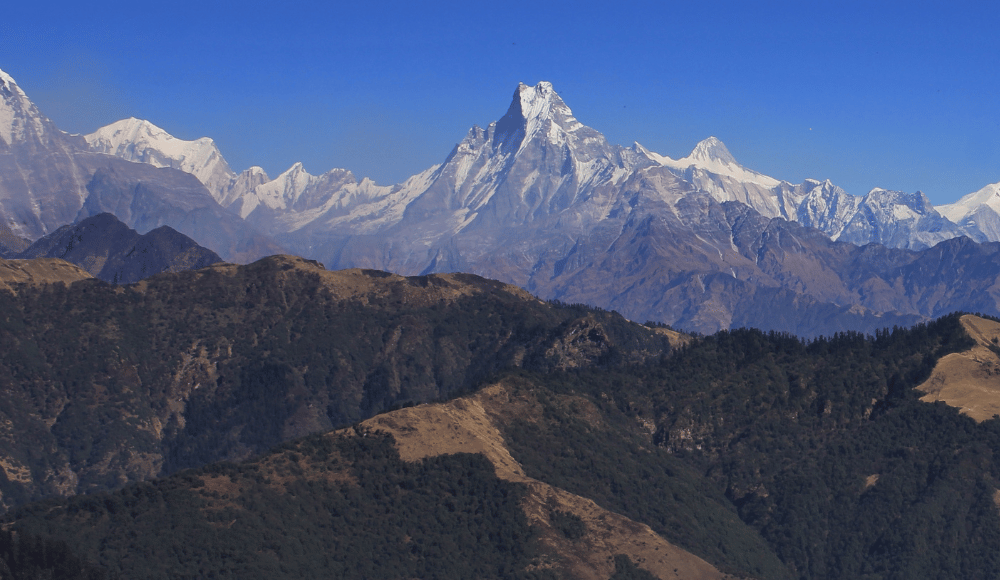
Sunrise from this hilltop looks Phenomenal. Also, there is a single community lodge on the hilltop. So, this trek not only grants mountain views, but you will also get a chance to dine and observe the beauty at the same time. This kind of facility is not available in any other trek, which makes this trek more exceptional. Also, you don't need a longer vacation for this trek as a physically fit person can even complete this trek within 5 to 6 days.
Shey Phoksundo lake trek is the trek on the hidden jewel of western Nepal. This Phoksundo lake lies in the Dolpo region, the largest yet the most remote district of Nepal, inside Phoksundo national park. Trekking in this region is far more difficult than the popular Annapurna and Everest region trek. During this Phoksundo lake trek, you will explore the remote Dolpo livelihood, cultural variations, flora, and fauna of Phoksundo national park, and unspoilt natural splendours. Also, keep it a note that to trek around the Dolpo region, you need to have at least 2 people in your group and a local licensed guide.
|
Name |
Shey Phoksundo lake trek |
|
Location |
Dolpo district |
|
Starting and Ending point |
Juphal |
|
Trek Duration |
8 to 9 days |
|
Highest Elevation |
3611 m |
|
Major attractions |
|
|
Permits required |
|
|
Difficulty level |
Difficult |
|
Accommodations |
Teahouses |
Phoksundo lake is the pristine freshwater oligotrophic lake considered sacred by the locals. The crystal clear turquoise water, the wonderful Kanjirowa reflection, the beautifully nestled Tibetan village, Ringmo on the lake shore, multiple gompas and monasteries, and the peaceful tranquil natural ambience make the trek to Phoksundo lake worth every pain and penny. Not just lake Phoksundo, but this lake trek will give the amazing opportunity to explore the most isolated Dolpo region and its trekking trails.
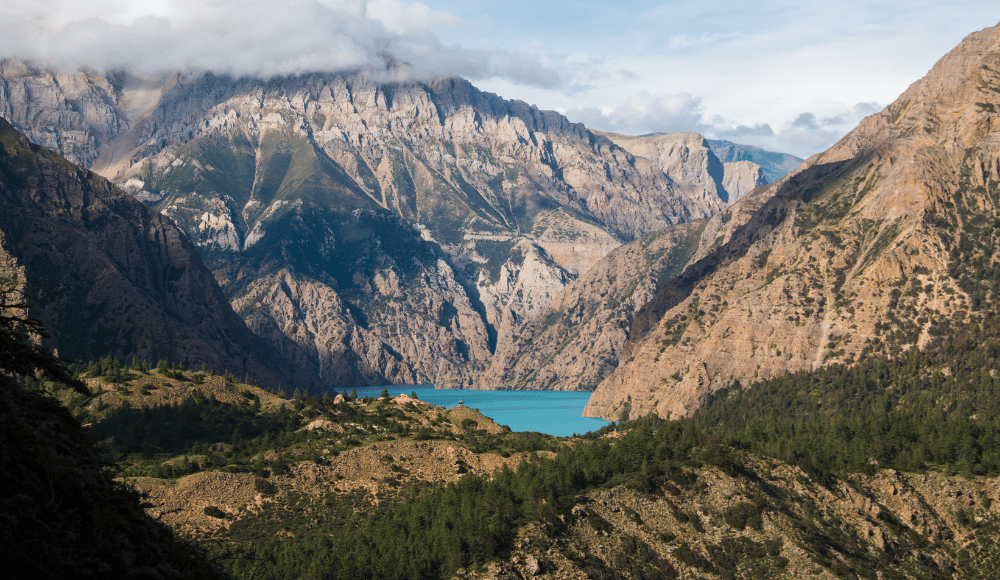
Dolpa region is still far behind in every developmental work and prospect. Finding a luxury will be a wild imagination here as you will observe the remote settlements and their lifestyles. Keep the luxury afar, it still lacks motor accessibility till now. The only way to reach here is a flight through Nepalgunj and the next to Juphal, from Juphal you have to trek onwards. Apart from this, there are no means to reach Dolpo.
You can find two different religions prominent in the villages in this region, one the Buddhist and the other the BonPo religion. So, you will get to observe several gompas and monasteries here. The popular Shey Gompa is the oldest Gompa in this region which bears a magnificent historical background. Every 12 years the grand Shey festival is organised in the courtyard of Shey Gompa, which is the greatest festival for the local residents. In addition to this, On the northern ridge of the Phoksundo lake there lies the Khowa monastery, which is revered with huge religious beliefs. You can see the locals and monks performing prayers in this monastery every single day.
Related read: 10 Popular Himalayan Festivals in Nepal
The next fascinating part of this Phoksundo trek is the beautiful village of Ringmo. It is an ancient village influenced by the Tibetan tribe, so the locals are seen adapting the Tibetan customs and practices. What is more surprising about this village trek is that the Bonpo and the Buddhist practices are the total opposite of each other but still the locals create a perfectly balanced religious harmony between them. So, this Phoksundo lake trek not only furnishes you with the scenic vistas of the awe-inspiring freshwater lake but also sets a ray into the remote lifestyles of the Dolpo region.
Panch Pokhari trek is more like a religious trek than the viewpoint trek in the Langtang region. Panch Pokhari simply means the association of five holy lakes distributed over the district of Sindhupachowk, Nuwakot and Rasuwa. In this trek, you will traverse through the least explored and unspoilt five holy lakes which are believed to be the origin of the Indravati river. The starting point of this trek is Bhotang via Melamchi, and this trek gets a large number of national visitors during Janai Purnima, especially Hindus and Buddhist pioneers.
|
Name |
Panch Pokhari trek |
|
Location |
Sindhupalchowk, Nuwakot and Rasuwa district ( Langtang region) |
|
Starting point |
Bhotang |
|
Ending point |
Chalauthi |
|
Trek Duration |
12 days |
|
Highest Elevation |
4100 m |
|
Major attractions |
|
|
Permits required |
|
|
Difficulty level |
Moderate |
|
Accommodations |
Camping and Homestay |
Not just the five lakes are the only attraction of this trek, they are the major one but not the only one. Accompanying you during the trek will be the Jugal Himal chain, valleys, glaciers, waterfalls, culture, customs and the pristine nature of the Langtang region. Mainly the trails to the holy lakes lie in the shadow of Jugal Himal.
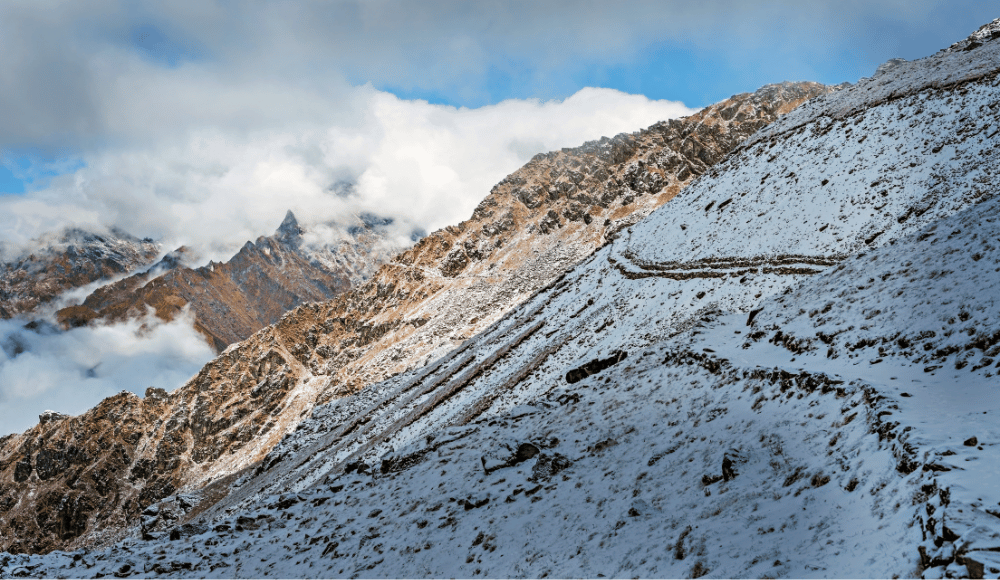
One distinct feature of this Panch Pokhari trek is that, unlike other regions, not so teahouses and lodges are available for this trek. In the lower region, some tea houses are available but in the upper range, you need to rely on camping, also the trails are quiet and serene. So, this trek is ideal for those who want to spend some time in peace, questing for spiritual healing, far from noisy urban life, in the lap of picturesque nature.
The temperature of Nepal during the winter months differ by region. Some regions experience severe cold, while some just get a cold crisp. The air becomes less humid and drier and the atmosphere remains cheerful throughout the day while the morning gets covered by the thick fog. Night becomes long and the days get shorter, while the sunsets faster than usual, making the night frosty. It is more common to get a drop in temperature during the night than in the days in the winter period. The average temperature in the winter months in the above-discussed trekking region is tabulated below. You can go through this.
|
Trek name |
Avg Min and Max temperature |
|
-10℃ to 10℃ |
|
-5℃ to 16℃ |
|
-6℃ to 14℃ |
|
-9℃ to 11℃ |
|
-7℃ to 13℃ |
|
-10℃ to 10℃ |
|
-7℃ to 13℃ |
|
-5℃ to 15℃ |
|
-6℃ to 14℃ |
|
-9℃ to 11℃ |
The most common winter trek difficulty is the varying weather and obviously the extreme coldness. The weather may become severe with heavy snowfalls sometimes. This will not only halt the trek but may result in some mishaps too. Also, it's hard to trek above the trails covered by the snow and there is a high chance of getting lost too. Apart from this, for the trek above 4000m, there is a huge possibility of getting high altitude sickness. Also, because of the extreme temperature drop, water freezes in most of the regions making it very difficult for daily life activities. These are the most common winter trek difficulties in Nepal which are also listed below:
Fluctuating weather
Extreme coldness and frostbite
Altitude sickness
Avalanches and Snowstorms
Shorter days and snow-covered trails
All other trekking essentials for winter are similar to the other season's trek. The only difference will be in clothing, as you have to pack thicker woollen clothes instead of cotton clothes during the winter treks. Since cotton clothes soak faster, it is not quite favourable for winter treks. Apart from this, all winter trekking backpack guides are similar to the regular trekking backpack and essentials. Additionally to this, you can add crampons to your backpack along with some comfortable hiking pairs.
Some of the notable winter trek guides and tips are listed below. You can take a reference from here.
Rules vary by region, so follow the rules and regulations of the region accordingly.
While layering the clothes, pay good attention, as you will sweat when you hike, and you don't want to be all wet and tacky.
Always carry some extra cash no matter what.
Always check the weather before starting any treks as you don't want to stuck in avalanches and snowstorms.
Trek in a group as you will get a hand in case of any emergencies.
Don't rush and start the trek slowly and gradually.
No matter which season you are trekking, always drink plenty of water and eat dietary foods.
If you get lost in the woods or trails, look for blue and white symbols in the trees as they are placed there directing you to the destination.
Before clicking the picture of the locals, entering the inner part of the temple, and getting yourself closer to them, first ask for their permission.
Also keep in mind that winter days are shorter, so plan the trek observing the following day's sunset and get to the destination in broad daylight, as it can be pretty troublesome to find the trail in the pitch dark.
Related read: Nepal travel information
There are multiple winter treks in Nepal. Some of the best are the Langtang valley trek, Panchpohari lake trek, Phoksundo lake trek, Everest view trek, Mardi Short trek, Mohare hill trek, Tamang heritage trail, Ghorepani Ghandruk trek, Pikey peak trek and Manang trek.
You need to especially take care of the winter backpack. First, you need to have a clear conscience about the weather around this time, so basically learning about layering the clothes is the best winter backpack guide. Additionally, you can add some crampons, the best hiking pairs, maps and compasses, a first aid kit, water bottles, sunscreens, a pair of glasses, and some comfortable thermal wear.
Yes, you can trek in Nepal even during the winter months. Nepal is considered unique because there is no limitation for the trekkers, as it offers a variety of trekking possibilities varied by the region and varied by the seasons. Trekking in lower elevations is much more practical during the cold winter months in Nepal.
The chill cool mountain air, snow-capped peaks, changing forest shades, foggy mornings, colourful pleasant early sunset, and the pristine natural ambience of the Himalayas make the winter trek in Nepal much more exceptional.
Yes, there is the possibility but no accuracy. In some regions like Everest and Annapurna, you will definitely find snowfall, but in other regions like Langtang and all, it is unpredictable, in late January there may be some but as mentioned above this relies on the regions’ temperature and rainfall.
Yes, except for some, camping is almost possible for every winter trek in Nepal. Camping is not just a part of trekking accommodation but gives a completely new experience in the lap of the scenic Himalayas.
Mardi short trek, Mohare hill trek, Ghorepani Ghandruk trek, and Langtang valley trek are the easiest winter treks in Nepal. Also, it may not take more than a week to complete these treks, some may even complete them within 4 to 5 days.
Yes, absolutely. To be completely wise, if you want to trek in Nepal, nothing can stop you, after all, your will is the only thing that matters. Simply, if you like you can, no need to exaggerate it.
The most favourable can be March, April, May, September, October and November. But if you want to escape the crowd, you can go for December, January and February.